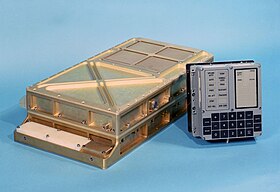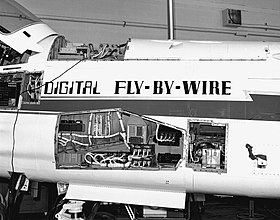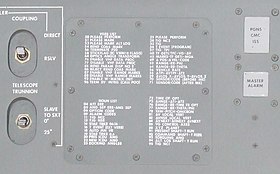Apollo guidance computer

The Apollo Guidance Computer ( AGC ) was in the Apollo space flights used computers for navigation . It was used to collect and provide flight information in real time , as well as to automatically control all navigation functions of the Apollo spacecraft . It was the first recognizable modern embedded system .
It was developed from 1961 for the Apollo program under the direction of Charles Stark Draper at the MIT Instrumentation Laboratory . The hardware used on the flights was manufactured by the US defense and electronics company Raytheon .
Use in the Apollo program
With every moon flight - apart from Apollo 8, which did not have a Lunar Module (LM) - two AGCs were used. One was in the command module (CM) of the Apollo spacecraft, responsible for navigation to the lunar orbit and back, and another in the lunar module , primarily responsible for the safe landing on the moon and the rendezvous with the command module when the ascent stage returned. Both systems were identical in construction, but equipped with different software ; the navigation data was compatible between the devices. The AGC was part of the so-called Primary Guidance, Navigation and Control System (PGNCS, pronounced: pings ), the independent inertial navigation system of the Apollo spacecraft.
In addition, two other computers were used on the moon missions:
- A flight computer called Launch Vehicle Digital Computer (LVDC), which was housed in the Booster Instrumentation Ring of the Saturn V. This was a serial computer built by the IBM Federal Systems Division.
- A small computer built by TRW in the so-called Abort Guidance System (AGS) of the lunar module. This should be used in the event of an error in the PGNCS. The AGS could be used to launch the Lunar Module from the moon and to rendezvous with the command module (CM), but not to land on the moon.
Use outside the Apollo program
In 1972 the AGC formed the basis for an experimental fly-by-wire system, which was installed in a Vought F-8 "Crusader" in order to demonstrate the feasibility and advantages of a computerized fly-by-wire system. The AGC was only used in the first phase of this project and replaced by another computer in a second phase. The research that followed led to the fly-by-wire system of the space shuttle and indirectly to the fly-by-wire systems of modern aircraft.
description
processor
The Apollo flight computer was the first to use integrated circuits (IC). The Block I version of the AGC used until 1966 was made up of 4100 ICs. Each of these ICs contained a single three input NOR gate . In the Block II version of the AGC used from Apollo 7 , two NOR gates with three inputs were housed in an IC with a flat-pack housing . About 5600 gates were installed. The gates built in RTL logic were manufactured by Fairchild Semiconductor . The wiring of the ICs was built up by means of a winding connection and cast in epoxy resin . The processor worked internally with 16-bit data words (14-bit data , 1 overflow bit and 1 sign bit (one's complement) ). When used as a program command, 3 bits were reserved for the opcode and 12 bits for the address.
Other special features:
- The processor worked in one's complement.
- The address area of the processor was only 1 or 4 Ki words depending on the command. In order to be able to address the entire memory, the memory was organized in switchable memory banks.
- The processor had a total of 6 timers.
Storage
The read / write memory (RAM) of the AGC was designed as a ring core memory and the read-only memory (ROM) as a core rope memory . The astronauts could write to the RAM area manually if necessary.
The Block I version of the AGC had a RAM with a capacity of 1024 data words of 16 bits each and a ROM with a capacity of 12288 data words of 16 bits each, which was later expanded to 24576 data words. The Block II version of the AGC had a RAM with a capacity of 2048 data words and a ROM with a capacity of 32768 data words of 16 bits each.
Both memories had a cycle time of 11.72 μs . The data words had a length of 16 bits (15 bits of data and 1 parity bit (odd parity)).
In today's terminology, which was not yet common at the time, the AGC had a total of 68 KiB of memory. 64 KiB were used as ROM for the stored software. The remaining 4 KiB served as RAM.
Clock
A crystal oscillator with a clock frequency of 2048 kHz was used as the primary clock generator for the AGC . This clock signal was divided by 2 to process the AGC's internal operations at a frequency of 1024 kHz. The 1024 kHz signal was also divided by 2 to generate a second clock signal with a frequency of 512 kHz. This clock, called MASTER FREQUENCY, was used to synchronize the external systems of the Apollo spacecraft.
software

After the development of software for the AGC was originally not included in the plan and budget of the Apollo program, over 300 people ultimately worked on it. One of the better known today is the flight and navigation program leader Margaret Hamilton . The term software engineering was established for the first time, along with numerous basic paradigms of the same. The priority scheduling in particular proved to be critical to the success of Apollo 11's first moon landing . The AGC software was written in assembly language. A real- time operating system called EXEX could handle up to seven processes weighted according to priority in a non-preventive multitasking process. Each process had to periodically return control to EXEX. An eighth process with diagnostic tasks was always running with the lowest priority. In addition, there was an interrupt driven component called WAITLIST.
User interface
The AGC's user interface was called DSKY (Display / Keyboard) and consisted of a series of numeric displays and a keyboard that was reminiscent of a pocket calculator . Commands were entered numerically as two-digit numbers. For the actual command there was the VERB (key verb ), while the parameters, if necessary, by pressing the NOUN ( main word is entered).
The command module had two DSKYs, one on the main instrument panel and one in the lower equipment compartment near the sextant for aligning the inertial navigation system. Both DSKY were operated by the same AGC. The lunar module only had one DSKY for its AGC.
Weight
Together with the interface, the AGCs in the Apollo capsule and in the lander weighed around 32 kg each.
literature
- Eldon C. Hall: Journey to the Moon: The History of the Apollo Guidance Computer . American Institute of Aeronautics and Astronautics, Inc., Reston, VA 1996, ISBN 1-56347-185-X .
- David A. Mindell: Digital Apollo: Human and Machine in Spaceflight . The MIT Press, Cambridge 2008, ISBN 978-0-262-13497-2 .
- Frank O'Brien: The Apollo Guidance Computer: Architecture and Operation . Springer, Berlin, New-York 2010, ISBN 978-1-4419-0876-6 .
Web links
- The Lunar Module Computer - from in Space: our gateway to the stars of the Australian Broadcasting Corporation (1999) ( English )
- Interview with Allan Klumpp , the principal designer of the software descent of the Apollo Lunar Module ( english )
- NASA Office of Logic Design: Schematics of the Apollo Guidance Computer ( English )
- Emulation software for Linux, Windows and Mac OS X 10.2 ( English )
- Source code of the AGC on GitHub
- Lecture on building the computer on the 34c3
- Moonjs: An Online Apollo Guidance Computer (AGC) Simulator
swell
- James Tomayko: The Apollo guidance computer: Hardware. In: Computers in Spaceflight: The NASA Experience. NASA, accessed May 23, 2017 .
- James Tomayko: The Apollo guidance computer: Software. In: Computers in Spaceflight: The NASA Experience. NASA, accessed May 23, 2017 .
- James Tomayko: Using the AGC. In: Computers in Spaceflight: The NASA Experience. NASA, accessed May 23, 2017 .
- Frank O'Brian: The AGC hardware. In: The Apollo Guidance Computer: Architecture and Operation. Springer Verlag, accessed on May 5, 2018 (English).
Individual evidence
- ↑ a b APOLLO GUIDANCE COMPUTER PROGRAM BLOCK I (100) AND BLOCK II . Raytheon. December 31, 1969. Retrieved August 27, 2017.
- ↑ Maia Weinstock: Scene at MIT: Margaret Hamilton's Apollo code . In: MIT News . August 17, 2016. Retrieved July 22, 2019.



